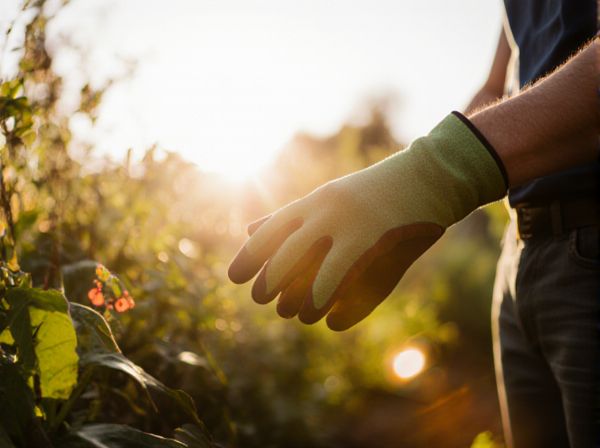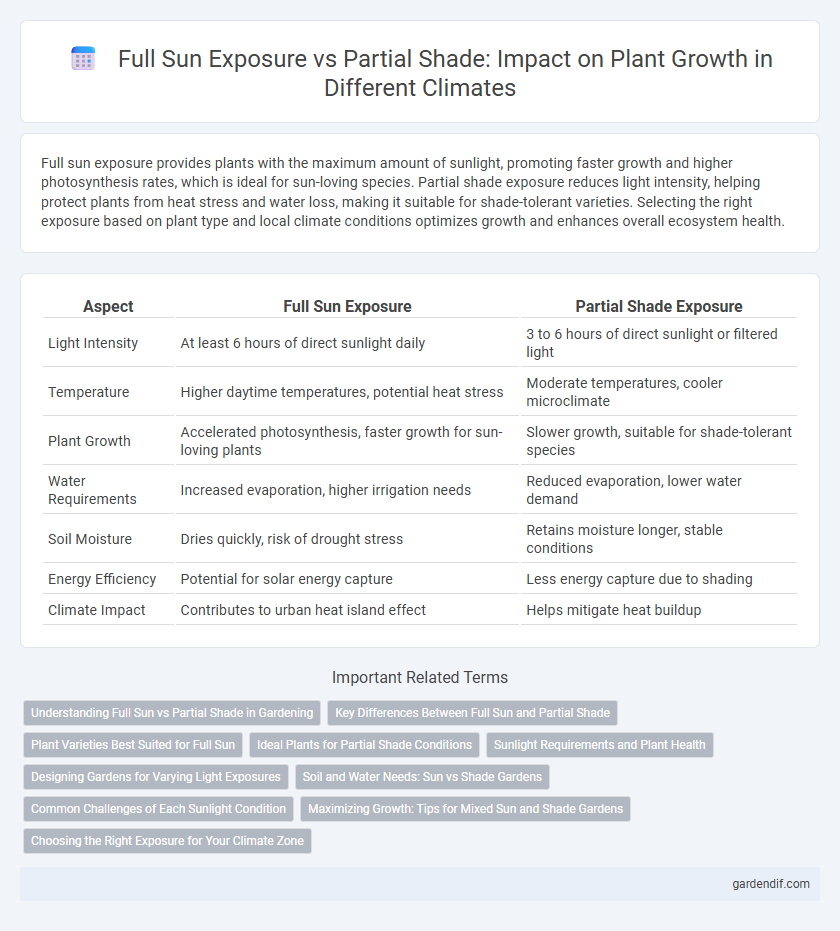
Full sun exposure vs partial shade exposure Illustration
Full sun exposure provides plants with the maximum amount of sunlight, promoting faster growth and higher photosynthesis rates, which is ideal for sun-loving species. Partial shade exposure reduces light intensity, helping protect plants from heat stress and water loss, making it suitable for shade-tolerant varieties. Selecting the right exposure based on plant type and local climate conditions optimizes growth and enhances overall ecosystem health.
Table of Comparison
| Aspect | Full Sun Exposure | Partial Shade Exposure |
|---|---|---|
| Light Intensity | At least 6 hours of direct sunlight daily | 3 to 6 hours of direct sunlight or filtered light |
| Temperature | Higher daytime temperatures, potential heat stress | Moderate temperatures, cooler microclimate |
| Plant Growth | Accelerated photosynthesis, faster growth for sun-loving plants | Slower growth, suitable for shade-tolerant species |
| Water Requirements | Increased evaporation, higher irrigation needs | Reduced evaporation, lower water demand |
| Soil Moisture | Dries quickly, risk of drought stress | Retains moisture longer, stable conditions |
| Energy Efficiency | Potential for solar energy capture | Less energy capture due to shading |
| Climate Impact | Contributes to urban heat island effect | Helps mitigate heat buildup |
Understanding Full Sun vs Partial Shade in Gardening
Full sun exposure requires at least six hours of direct sunlight daily, promoting vigorous growth and abundant flowering in sun-loving plants such as tomatoes and lavender. Partial shade, characterized by three to six hours of sunlight or filtered light, benefits shade-tolerant species like ferns and impatiens by preventing heat stress and moisture loss. Selecting appropriate plants for full sun or partial shade conditions enhances garden health, water efficiency, and crop yield under varying climate patterns.
Key Differences Between Full Sun and Partial Shade
Full sun exposure involves at least six hours of direct sunlight daily, essential for photosynthesis and optimal growth in sun-loving plants like tomatoes and sunflowers. Partial shade exposure provides three to six hours of sunlight or filtered light throughout the day, benefiting shade-tolerant species like ferns and begonias by reducing heat stress and conserving moisture. Understanding these distinctions helps optimize plant health, water usage, and energy efficiency in different climatic regions.
Plant Varieties Best Suited for Full Sun
Plant varieties best suited for full sun exposure include sun-loving species such as tomatoes, peppers, lavender, and sunflowers, which require at least six hours of direct sunlight daily to thrive. These plants develop stronger stems, produce higher yields, and exhibit vibrant blooms under intense sunlight conditions. Full sun exposure enhances photosynthesis efficiency, promoting vigorous growth and optimal fruit or flower production in heat-tolerant cultivars.
Ideal Plants for Partial Shade Conditions
Partial shade conditions favor plants such as hostas, ferns, and astilbes, which thrive with limited direct sunlight while benefiting from filtered light. These plants demonstrate higher resilience to heat stress and reduced water requirements compared to full sun species. Choosing shade-tolerant plants supports biodiversity and maintains soil moisture in climates with intense sun exposure.
Sunlight Requirements and Plant Health
Full sun exposure, defined as at least six hours of direct sunlight daily, promotes optimal photosynthesis and vigorous growth in sun-loving plants like tomatoes and lavender. Partial shade exposure, receiving approximately three to six hours of sunlight or filtered light, reduces stress and prevents leaf scorch in shade-tolerant species such as ferns and hostas. Balancing sunlight requirements with plant health ensures maximum nutrient absorption and disease resistance, crucial for sustainable gardening and climate adaptability.
Designing Gardens for Varying Light Exposures
Designing gardens for varying light exposures involves selecting plants based on their sun tolerance, with full sun areas supporting sun-loving species like roses and lavender that require at least six hours of direct sunlight daily. Partial shade zones, which receive four to six hours of filtered or indirect light, are ideal for shade-tolerant plants such as hostas, ferns, and impatiens, which thrive without the stress of intense midday sun. Optimizing plant placement according to sun exposure enhances growth, bolsters plant health, and creates balanced, visually appealing garden ecosystems adapted to local climate conditions.
Soil and Water Needs: Sun vs Shade Gardens
Full sun gardens demand well-drained, nutrient-rich soil with consistent moisture to support high transpiration rates and prevent water stress. Shade gardens thrive in cooler, moisture-retentive soils that reduce evaporation, necessitating less frequent watering but improved organic matter to maintain soil fertility. Understanding these soil and water dynamics enhances plant health, promoting sustainable garden management under varying climate conditions.
Common Challenges of Each Sunlight Condition
Full sun exposure often causes increased water evaporation and heat stress in plants, leading to challenges such as wilting and sunburn. Partial shade conditions can limit photosynthesis, resulting in slower growth and reduced flowering intensity. Both sunlight conditions demand careful management of watering schedules and plant selection to optimize health and productivity.
Maximizing Growth: Tips for Mixed Sun and Shade Gardens
Choosing the right plant varieties for mixed sun and shade gardens significantly boosts growth by matching species to their optimal light requirements. Full sun exposure supports photosynthesis for sun-loving plants, while partial shade offers protection from intense heat and reduces water stress for shade-tolerant species. Strategic garden design incorporating sun and shade zones maximizes overall plant health and growth by balancing light, temperature, and moisture levels.
Choosing the Right Exposure for Your Climate Zone
Full sun exposure suits regions with cooler climates where plants benefit from maximum sunlight for photosynthesis and growth, reducing the risk of fungal diseases. Partial shade exposure is ideal for warmer or arid climate zones, protecting plants from intense heat and minimizing water loss through evaporation. Selecting the correct sun exposure based on your climate zone enhances plant health, optimizes irrigation efficiency, and improves overall garden productivity.
Full sun exposure vs partial shade exposure Infographic

 gardendif.com
gardendif.com